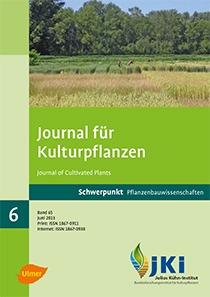Estimating humus reproduction of bioenergy crops
DOI:
https://doi.org/10.5073/JfK.2013.06.02Keywords:
Bioenergy crops, humus balance, modeling, soil organic matterAbstract
The production of bioenergy crops is increasing in Germany, and today these crops already occupy a relevant share of the total arable land. For environmental impact assessment, the humus balance of bioenergy crop production systems is one important figure. However, the necessary humus balance coefficients are not available for these crops until now. One problem in generating these coefficients for the actual German standard method for humus balancing (VDLUFA, 2004) is that the included coefficients have been derived from long-term field experiments, but a reproducible procedure for the calculation of new coefficients has not been specified. Therefore, we present results from modeling humus reproduction of different bioenergy crops with the HU-MOD approach. The model in principal allows for the calculation of balance coefficients for the VDLUFA (2004) method. Model performance in the assessment of bioenergy crops is tested based on literature data on Zea mais and Miscanthus × giganteus. According to the HU-MOD model, all bioenergy crops under assessment exhibit considerably negative humus reproduction, with Miscanthus × giganteus as an exception. Calculated humus reproduction is in a plausible magnitude, as supported by the calibrated model application with Zea mais and Miscanthus × giganteus. However, the parametrization of the humus balance model is hindered by a very limited availability of data, especially with regard to below ground biomass. Further, the data base for validations of the new coefficients is extremely insufficient, indicating the strong demand for more efforts in data supply.
Downloads
Published
Issue
Section
License
The content of the journal is licensed under the Creative Commons Attribution 4.0 License. Any user is free to share and adapt (remix, transform, build upon) the content as long as the original publication is attributed (authors, title, year, journal, issue, pages).
The copyright of the published work remains with the authors. The authors grant the Journal of Cultivated Plants, the Julius Kühn-Institut and the OpenAgrar repository the non-exclusive right to distribute and exploit the work.







